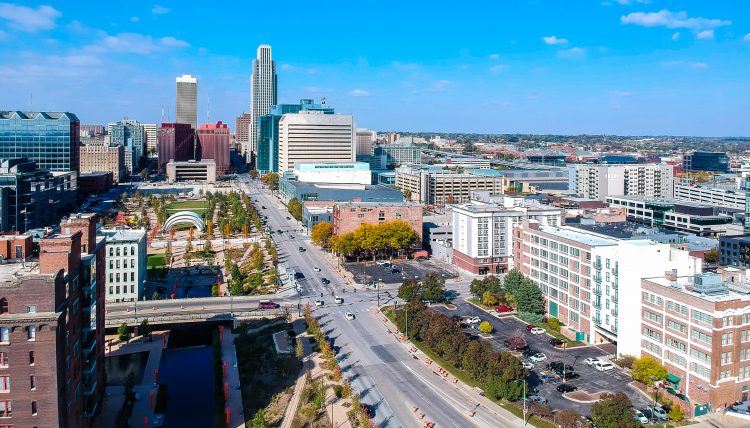From a young age, we all have an idea of a dream destination that we’d like to call home; somewhere luxurious on the water, or in some cases, a small remote cabin on a lake far from civilization. The idea to call a house or community our own is what most in modern society strive for, making the ultimate sacrifices to achieve the American Dream. But, the question often comes down to, “which place is right for me?” According to Forbes’ “The Best Cities to Move to in 2024” report, the Top 5 seem just about right for anybody—and the results may surprise you.
Grades for each city on the list were determined by Forbes based on housing costs, cost of living, crime rates, air quality, quality of education, median income, employment rates, weather, entertainment establishments, average commute time and net migration to the city.
Here are the Top 5 best cities to move to in 2024:
No. 1: Omaha, Nebraska
First on the list ranks Omaha, Nebraska, a midwest city of 477,705 people. While the city lost nearly 5,000 residents between 2016 and 2020, the employment rate is 98%, with a yearly salary of $69,198. Affordability is the key here, as average monthly housing costs are just $1,188. Forbes determined Omaha was the ultimate hotspot across the nation, granting the city a perfect score of 100/100.
Pete Thompson, senior vice president of the Omaha Chamber of Commerce, says that the strong local economy is a major factor in making Omaha desirable to newcomers and residents alike.
“We believe that our steady and strong economy is one major factor in making Omaha a desirable place for people,” says Thompson. “We have enjoyed consistently low unemployment, and a combination of well-established, Fortune 500 presence, in addition to a robust startup ecosystem. The stable employment rate close to 98%, as mentioned, reflects not only the resilience and diversity of our job market, but also the supportive environment for entrepreneurs and businesses of all sizes. This stability attracts talent and investment—which, in turn, fuels further economic stability and growth.”
Thompson goes on to share that with such a high employment rate citywide, “this stability attracts talent and investment, further fueling economic stability and growth.”
Omaha attractions consist of Various Fortune 500 companies such as Berkshire Hathaway and Aflac, University of Nebraska Medical Center—now one of the premier cancer research facilities in the U.S.—Omaha’s Henry Doorly Zoo and Aquarium, The Durham Museum, Omaha Children’s Museum and the Mormon Trail Center. Creighton University and University of Nebraska Omaha, who each boast respected Division 1 athletics, also offer masters and doctorate and medical and dental programs.
Offutt Air Force Base and U.S. Strategic Command, both contributing to military and civilian job growth, also contribute to Omaha’s flourishing economy.
“The relatively affordable cost of living, paired with a competitive income, makes Omaha an attractive place for young professionals, families and retirees,” explains Thompson. “This affordability enhances residents’ quality of life, allowing them more discretionary spending and savings opportunities, which benefits local businesses.
“Our Midwestern friendliness and work ethic make this a great place to be.”
No. 2: Raleigh, North Carolina
Raleigh, North Carolina, comes in at No. 2, with a slight statistical score drop-off, receiving an 83.12 out of 100. The average income for someone in Raleigh is nearly $81,000, and rent is just higher than Omaha, at an average of $1,446. Employment is 97%.
Stu Barnes, broker/owner of Barnes McQuade Realty, notes that the benefits associated with a thriving local economy as well as reasonable costs are at the forefront for buyers looking to head south.
“The local economy is a great draw to our area,” he says. “I have buyers coming here from the Northeast, mainly because of the high cost of living there and very heavy traffic compared to our area. I’d also say that houses around here are fairly new, built in 1980 or later in most areas, compared to higher-density areas where housing is older and needs much more work on the home.”
Barnes goes on to explain how weather is a major factor in folks choosing to move to the Raleigh area. In fact, 14,919 people between 2016 and 2020 migrated to Raleigh, which is the highest of any city in Forbes’ Top 5.
“Weather is a pretty big factor here,” says Barnes. “Though we do have snow and cold weather occasionally, it is nowhere near certain parts of the country. Same thing for summertime. We do have high humidity, but I don’t think it’s as bad as the more southern states. The Raleigh area is about two hours to the beaches and three hours to the mountains, so people love the convenience of being close to both.”
Barnes says that several universities also help with the migration of Americans from around the country, as Duke, NC State, UNC, Wake Forest and ECU are roughly an hour and a half away. The Carolina Hurricanes NHL team is also a big draw.
“I have so many clients that move here and are amazed about how much emphasis is put on college sports. The reason is we don’t have many professional sports here other than the Hurricanes and the Durham Bulls, so college sports get a lot of attention.”
No. 3: Oklahoma City, Oklahoma
Home to major market professional teams like the NBA’s Oklahoma City Thunder, who rank first in the Western Conference of the league, Forbes gave Oklahoma City, Oklahoma (OKC) a B-, or 80.25 out of 100. OKC also boasts an employment rate of 97%, with an average housing cost of $1,081. Residents average an annual income of $57,000.
Visitokc.com notes that a few things to do once settled in the city include experiencing the Bricktown Water Taxi, visiting Conestoga Wagons & Teepees at Orr Family Farm, Factory Obscura, First Americans Museum and Myriad Botanical Gardens. For sports fans, watching Thunder player Shai Gilgeous Alexander pour in 32 points per game at Paycom Center—which seats over 18,000—is also a necessity.
No. 4: Wichita, Kansas
Yet another midwestern state creeps into the top five, with Wichita, Kansas, at spot four, receiving a score of 80.02 out of 100. Complete with beautiful mountains and scenery, Wichita holds a 98% employment rate, which points to a thriving economy and labor market, beneficial for small businesses and residents alike. The average income sits at $60,856, with the average monthly housing cost at $930.
Wichita boasts beautiful landmarks like The Keeper of the Plains, Botanica: The Wichita Gardens, Tanganyika Wildlife Park—and for sports fans, the Division 1 Wichita State Shockers, who have undeniably one of the strongest fanbases in college athletics.
No. 5: Colorado Springs, Colorado
To cap off the top five, Colorado Springs, Colorado, scored a 79.56 out of 100. Another city with a strong employment rate (97%) and relatively low housing costs—$1,500 monthly—the median family income is $69,266.
Colorado Springs may have the most beautiful land sights on the list, with the Garden of the Gods park, Red Rock Canyon—often adventured by avid hikers—and The Broadmoor Seven Falls—a tourist attraction of seven cascading waterfalls.












